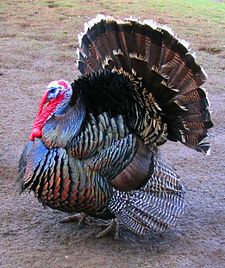Domestic turkey
| Domesticated turkey | |
|---|---|
 |
|
| A broad breasted bronze male (tom) displaying. | |
|
Domesticated
|
|
| Scientific classification | |
| Kingdom: | Animalia |
| Phylum: | Chordata |
| Class: | Aves |
| Order: | Galliformes |
| Family: | Phasianidae |
| Subfamily: | Meleagridinae |
| Genus: | Meleagris |
| Species: | M. gallopavo |
| Binomial name | |
|
Meleagris gallopavo (Linnaeus, 1758) |
|
| Nutritional value per 100 g (3.5 oz) | |
|---|---|
| Energy | 465 kJ (111 kcal) |
|
0 g
|
|
| Sugars | 0 g |
| Dietary fiber | 0 g |
|
0.7 g
|
|
|
24.6 g
|
|
| Vitamins | |
| Thiamine (B1) |
(0%)
0 mg |
| Riboflavin (B2) |
(8%)
0.1 mg |
| Niacin (B3) |
(44%)
6.6 mg |
| Pantothenic acid (B5) |
(14%)
0.7 mg |
| Vitamin B6 |
(46%)
0.6 mg |
| Folate (B9) |
(2%)
8 μg |
| Vitamin C |
(0%)
0 mg |
| Minerals | |
| Calcium |
(1%)
10 mg |
| Iron |
(9%)
1.2 mg |
| Magnesium |
(8%)
28 mg |
| Phosphorus |
(29%)
206 mg |
| Potassium |
(6%)
293 mg |
| Sodium |
(3%)
49 mg |
| Zinc |
(13%)
1.2 mg |
|
|
| Percentages are roughly approximated using US recommendations for adults. Source: USDA Nutrient Database |
|
The domesticated turkey (Meleagris gallopavo) is a large poultry bird, one of the two species in the genus Meleagris and the same as the wild turkey. Although turkey domestication was thought to have occurred in central Mesoamerica at least 2,000 years ago, recent research suggests a possible second domestication event in the Southwestern United States between 200 BC and AD 500. However, all of the commercial domesticated turkey varieties today descend from the domesticated turkey raised in central Mexico that was subsequently imported into Europe by the Spanish in the 16th century.
Turkey meat is a popular form of poultry, and turkeys are raised throughout temperate parts of the world, partially because industrialized farming has made it very cheap for the amount of meat it produces. Female domesticated turkeys are referred to as hens, and the chicks may be called or . In the United States, the males are referred to as toms, while in Europe, males are stags.
The great majority of domesticated turkeys are bred to have white feathers because their pin feathers are less visible when the carcass is dressed, although brown or bronze-feathered varieties are also raised. The fleshy protuberance atop the beak is the snood, and the one attached to the underside of the beak is known as a wattle.
The English language name for this species results from an early misidentification of the bird with an unrelated species which was imported to Europe through the country of Turkey.
The modern domesticated turkey is descended from one of six subspecies of wild turkey: Meleagris gallopavo, found in the area bounded by the present Mexican states of Jalisco, Guerrero, and Veracruz Ancient Mesoamericans domesticated this subspecies, using its meat and eggs as major sources of protein and employing its feathers extensively for decorative purposes. The Aztecs associated the turkey with their trickster god Tezcatlipoca, perhaps because of its perceived humorous behavior.
...
Wikipedia
